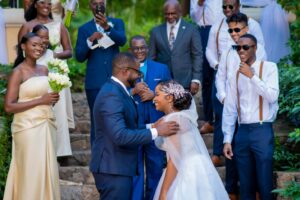Lawyer questions why envelope with exhibit was torn
Keith Clarke murder trial
A deputy superintendent of police, who was involved in the investigation of the shooting death of accountant Keith Clarke, admitted on Wednesday that an envelope containing metal fragments which was taken from the scene at Clarke’s house was torn when he collected it from the Kingston Central Police in May 2012.
The deputy superintendent, who at the time was a sergeant assigned to the Bureau of Special Investigations (BSI), faced cross-examination on Wednesday from King’s Counsel Peter Champagnie, who is representing Jamaica Defence Force (JDF) soldier Lance Corporal Odel Buckley. Buckley is one of three soldiers charged with murder in relation to the shooting death of Clarke. The other two are Lance Corporal Greg Tingling and Private Arnold Henry.
Clarke was shot more than 20 times, including in the back during a police-military operation to try and capture then fugitive Christopher “Dudus” Coke, who was wanted in the United States for drugs and weapons offences. It is alleged that Coke and seven to eight of his heavily armed henchmen were hiding out in the basement of Clarke’s residence.
During cross-examination on behalf of all the accused, Champagnie sought to pull from the policeman whether it was important to ensure that items of evidential value were treated with great care. Champagnie asked the policeman to say how long he had been in the constabulary force, as he sought to establish the point that he definitely should have been familiar with the correct operating procedures relating to securing evidence.
“I have been in the JCF for 31 years and seven months. As a sergeant I was assigned to BSI. In that role I investigated a number of cases. In the process of investigating, I had occasions where I handled and dealt with exhibits. An exhibit is something of evidential value which at all times should be secured properly. I totally agree that care should be exercised to preserve such exhibits,” the deputy superintendent told the seven-member jury and trial Judge Dale Palmer from a remote location.
He gave his evidence in court via a Zoom link.
“On August 22, 2012, I received an envelope which was a potential exhibit. On May 27, 2010 the metal fragments were collected in the envelope. I agree that the envelope was torn,” the cop said, explaining that he didn’t work independently of the Jamaica Constabulary Force and could not say how the envelope got torn.
The policeman also testified that he retrieved from the exhibit storeroom at Kingston Central Police Station a sealed, transparent bottle containing liquid substance and a bullet fragment that was taken from the body of a JDF corporal. The witness said he had no interaction with the soldier who the bullet was allegedly taken from. The bullet was said to have been removed from the body of the soldier by a doctor at Medical Associates Hospital in St Andrew.
Matthew Noedel, who was a US-based firearms expert consultant to the Independent Commission of Investigations (INDECOM) in 2012, gave evidence as well on Wednesday. Noedel spoke about his analysis of the rifles that were fired by the soldiers, among other items.
Noedel told the court that he received and analysed three 5.56 calibre Colt M4 rifles that were allegedly used by Tingling, Buckley and Henry during the operation which led to the death of Clarke on May 27, 2010. He said he test fired the rifles and stored the bullets and spent cartridges as reference samples.
“Each gun was fired six times and bullets and cartridge cases were stored in envelopes and labelled as test fire. The samples were left at the JCF laboratory. I handed them over at the Government laboratory but I don’t recall who retained them. On December 20, 2012, I was at the INDECOM office and had made arrangements to examine two recovered projectiles at the INDECOM microscopy lab. That morning members of the Government lab, the BSI and a video crew came to INDECOM and transferred exhibits called C and CK.
“C contained a small bullet jacket fragment. CK contained the upper half of a fired bullet. Item CK had green paint on the tip. The CK package had seals that demonstrated that it was a closed package. I received it from someone at the Government laboratory. Notes were made but I don’t have access to those notes. Item C, I viewed it visually by looking at it through the microscope. I also weighed the item and made measurements of them. For item CK, I repeated the same process,” Noedel told the court.
In this June 24, 2010 file photo, United States DEA agents take then reputed Jamaican gang leader Christopher “Dudus” Coke from Westchester County Airport to a waiting vehicle in White Plains, New York. Jamaican security forces had gone to Keith Clarke’s house on May 27, 2010 in search of Coke.
CLARKE… killed by soldiers on May 27, 2010 at St Andrew home during search for Dudus













